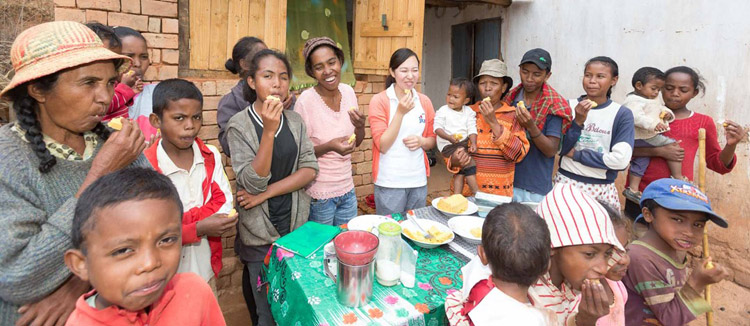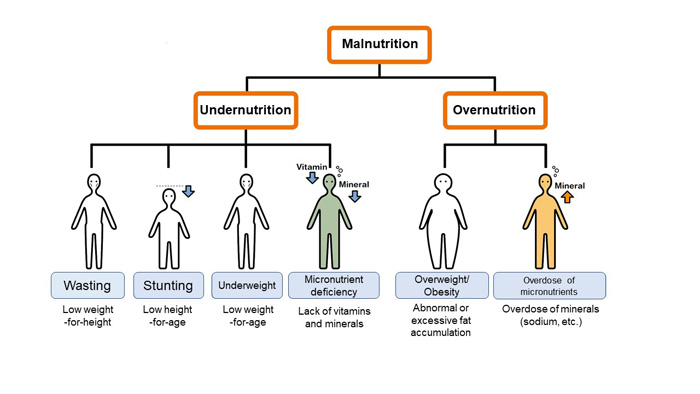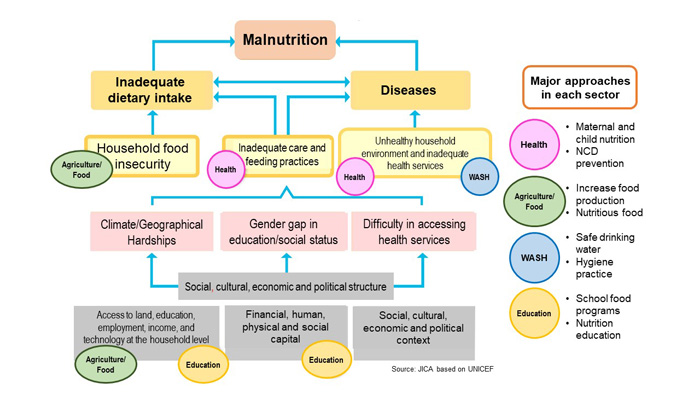
1. Double burden of malnutrition
Overnutrition of children is currently on the rise in many countries of the world, including developing countries, but undernutrition is a relevant factor in 45% of under-five deaths [1] . Both undernutrition, which impedes healthy growth, and overnutrition, which leads to various diseases including diet-related noncommunicable diseases (NCDs), significantly affect human life and health (Figure 1).
Around the world, about one in nine people is suffering from either starvation or undernutrition: 22% of children under five years of age are stunted, 7% are wasted, 15% of newborn babies have low birth weight, and 40% of pregnant women are anemic [2] . In particular, undernutrition during the "first 1,000 days of life" [3] can cause delays in a child's physical and intellectual development, and have a negative impact on schooling outcomes and labor productivity at later ages, eventually leading to a loss of national productivity.
Regarding overnutrition, 6% of children under five are overweight while 13% of adults are suffering from obesity with a BMI of 30 or higher [2] . Overnutrition increases the risk for diet-related NCDs, which in turn imposes a large social and economic burden such as premature deaths, prolonged treatment, disability from complications, as well as lower productivity and higher medical and social-security costs.
The prevalence of undernutrition is high in Africa and Asia. Especially in Africa, undernutrition in children still shows an increasing trend. However, micronutrient deficiency is actually present even in developed countries as well. Furthermore, the rise in overnutrition worldwide is causing various health problems. This is known as the "double burden of malnutrition," which is characterized by the coexistence of undernutrition along with overweight and obesity, or diet-related NCDs, within individuals, households and populations, and across the course of life [4] .

Figure 1: Classification of malnutrition
Notes
- [1] Source: WHO Fact Sheet "Malnutrition" (external link)
- [2] Source: Global Nutrition Report 2020 (external link)
-
[3] The time spanning roughly between conception and a child's second birthday
(UNICEF, The first 1,000 days of life: The brain's window of opportunity (external link)) - [4] Source: WHO, Double burden of malnutrition (external link)
2. A multi-sectoral approach to improved nutrition
Various factors can affect the state of an individual's nutrition. These include access to adequate food, appropriate caregiving for children and women such as breastfeeding and complementary feeding, access to health services, and safe water, sanitation and hygiene (WASH) services. Without appropriate conditions, people will not be able to have enough food or be able to absorb nutrients, leading to various diseases as well as malnutrition. (Figure 2)
Therefore, to tackle malnutrition, it is important to plan a multi-sectoral intervention across various fields such as health, agriculture and food, WASH, and education.

Figure 2: Causes of malnutrition and JICA's approach
3. JICA's Approach
Sustainable Development Goal (SDG) 2 aims to address the nutritional needs of adolescent girls, pregnant women, and the elderly to eliminate all forms of malnutrition by 2030. In addition, the Global Nutrition Targets 2025 [5] , set in 2012, aspire to reduce the double burden of maternal and child malnutrition by 2025. However, very few countries have been on track to meet these nutrition-related targets, and stronger cooperation by the international community is needed.
JICA actively promotes efforts for improved nutrition through cooperation in the field of maternal, newborn, and child health (MNCH) with a special focus on the "first 1,000 days of life," where nutrition intervention is expected to be most effective. JICA will also strengthen its support to developing countries to tackle the issue of overnutrition as part of the fight against NCDs. In addition, efforts will be made to improve nutrition through the Initiative for Food and Nutrition in Africa, or IFNA [6] , by deepening partnerships with international organizations to ensure people's access to adequate food. Moreover, the JICA Hand Washing for Health and Life Movement [7] supports improvements in sanitation and hygiene behavior. JICA also participates in the Scaling Up Nutrition (SUN) Movement [8] as a member of the lead group, which links various initiatives as well as diverse partners encompassing civil society, business, and international organizations.
Notes
- [5] Global Nutrition Targets 2025 (external link)
- [6] Initiative for Food and Nutrition in Africa (IFNA) (external link)
- [7] JICA Hand Washing for Health and Life
- [8] Scaling Up Nutrition (SUN) (external link)
4. JICA Nutrition Declaration "Nutrition for All: Ten-Point Commitment to Realize Human Security"
In December 2021, the Government of Japan hosted the "Tokyo Nutrition for Growth (N4G) Summit 2021" [9] .
Regarding bilateral cooperation in the field of nutrition, JICA announced the JICA Nutrition Declaration "Nutrition for All: Ten-Point Commitment to Realize Human Security" [10] at the summit.
Japan, is expected to contribute to strengthening partnerships and building momentum with various stakeholders in the quest to improve nutrition worldwide. Leveraging such high-level international momentum, JICA continues to work toward improving nutrition by strengthening the capacity of developing countries to address nutrition through a multi-sectoral approach, as well as by collaborating with various partners, including international organizations and private companies.
Notes




scroll